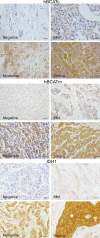Differential expression of the BCAT isoforms between breast cancer subtypes
- PMID: 33367952
- PMCID: PMC8065012
- DOI: 10.1007/s12282-020-01197-7
Differential expression of the BCAT isoforms between breast cancer subtypes
Abstract
Background: Biological characterisation of breast cancer subtypes is essential as it informs treatment regimens especially as different subtypes have distinct locoregional patterns. This is related to metabolic phenotype, where altered cellular metabolism is a fundamental adaptation of cancer cells during rapid proliferation. In this context, the metabolism of the essential branched-chain amino acids (BCAAs), catalysed by the human branched-chain aminotransferase proteins (hBCAT), offers multiple benefits for tumour growth. Upregulation of the cytosolic isoform of hBCAT (hBCATc), regulated by c-Myc, has been demonstrated to increase cell migration, tumour aggressiveness and proliferation in gliomas, ovarian and colorectal cancer but the importance of the mitochondrial isoform, hBCATm has not been fully investigated.
Methods: Using immunohistochemistry, the expression profile of metabolic proteins (hBCAT, IDH) was assessed between breast cancer subtypes, HER2 + , luminal A, luminal B and TNBC. Correlations between the percentage and the intensity of protein expression/co-expression with clinical parameters, such as hormone receptor status, tumour stage, lymph-node metastasis and survival, were determined.
Results: We show that hBCATc expression was found to be significantly associated with the more aggressive HER2 + and luminal B subtypes, whilst hBCATm and IDH1 associated with luminal A subtype. This was concomitant with better prognosis indicating a differential metabolic reliance between these two subtypes, in which enhanced expression of IDH1 may replenish the α-ketoglutarate pool in cells with increased hBCATm expression.
Conclusion: The cytosolic isoform of BCAT is associated with tumours that express HER2 receptors, whereas the mitochondrial isoform is highly expressed in tumours that are ER + , indicating that the BCAT proteins are regulated through different signalling pathways, which may lead to the identification of novel targets for therapeutic applications targeting dysregulated cancer metabolism.
Keywords: BCAT; Breast cancer; HER2 +; IDH; Luminal A.
Conflict of interest statement
The authors declare that they have no conflict of interest statement.
Figures







Similar articles
-
St Gallen molecular subtypes in primary breast cancer and matched lymph node metastases--aspects on distribution and prognosis for patients with luminal A tumours: results from a prospective randomised trial.BMC Cancer. 2013 Nov 25;13:558. doi: 10.1186/1471-2407-13-558. BMC Cancer. 2013. PMID: 24274821 Free PMC article.
-
Characteristics and outcomes according to molecular subtypes of breast cancer as classified by a panel of four biomarkers using immunohistochemistry.Breast. 2012 Feb;21(1):50-7. doi: 10.1016/j.breast.2011.07.008. Epub 2011 Aug 23. Breast. 2012. PMID: 21865043
-
Breast cancer in Ethiopia: evidence for geographic difference in the distribution of molecular subtypes in Africa.BMC Womens Health. 2018 Feb 14;18(1):40. doi: 10.1186/s12905-018-0531-2. BMC Womens Health. 2018. PMID: 29444670 Free PMC article.
-
Discordance and clinical significance of ER, PR, and HER2 status between primary breast cancer and synchronous axillary lymph node metastasis.Med Oncol. 2014 Jan;31(1):798. doi: 10.1007/s12032-013-0798-y. Epub 2013 Dec 5. Med Oncol. 2014. PMID: 24307349 Review.
-
Emerging Moonlighting Functions of the Branched-Chain Aminotransferase Proteins.Antioxid Redox Signal. 2021 May 1;34(13):1048-1067. doi: 10.1089/ars.2020.8118. Epub 2020 Aug 3. Antioxid Redox Signal. 2021. PMID: 32635740 Review.
Cited by
-
Nuclear Receptor-Mediated Metabolic Reprogramming and the Impact on HR+ Breast Cancer.Cancers (Basel). 2021 Sep 26;13(19):4808. doi: 10.3390/cancers13194808. Cancers (Basel). 2021. PMID: 34638293 Free PMC article. Review.
-
Branched-chain amino acids catabolism and cancer progression: focus on therapeutic interventions.Front Oncol. 2023 Aug 10;13:1220638. doi: 10.3389/fonc.2023.1220638. eCollection 2023. Front Oncol. 2023. PMID: 37637065 Free PMC article. Review.
-
Isocitrate dehydrogenase 1 gene mutations: a case review unveiling its biological impact on disease progression, prognosis and treatment in Chilean patients.BJR Case Rep. 2025 Mar 24;11(2):uaaf019. doi: 10.1093/bjrcr/uaaf019. eCollection 2025 Mar. BJR Case Rep. 2025. PMID: 40182999 Free PMC article. Review.
-
Mass Spectrometry-Based Proteomics Technologies to Define Endogenous Protein-Protein Interactions and Their Applications to Cancer and Viral Infectious Diseases.Mass Spectrom Rev. 2025 Feb 9:10.1002/mas.21926. doi: 10.1002/mas.21926. Online ahead of print. Mass Spectrom Rev. 2025. PMID: 39924651 Free PMC article. Review.
-
Expression of 3-Methylcrotonyl-CoA Carboxylase in Brain Tumors and Capability to Catabolize Leucine by Human Neural Cancer Cells.Cancers (Basel). 2022 Jan 24;14(3):585. doi: 10.3390/cancers14030585. Cancers (Basel). 2022. PMID: 35158853 Free PMC article.
References
MeSH terms
Substances
LinkOut - more resources
Full Text Sources
Medical
Research Materials
Miscellaneous

